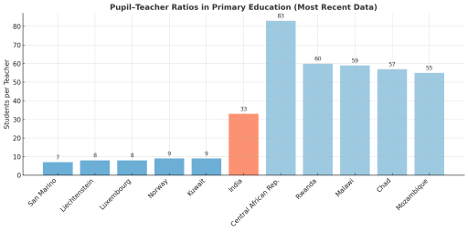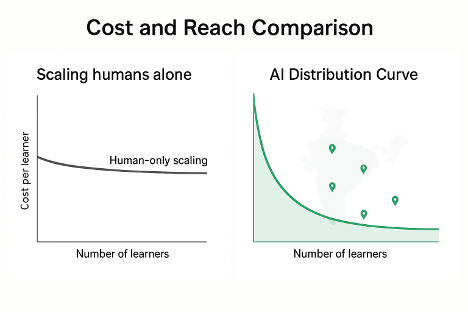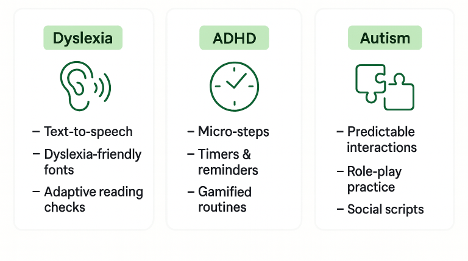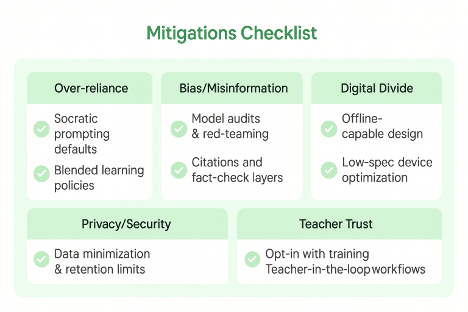Personalized Learning for All: How AI Is a Game-Changer for Students Without Access to Quality Education

"Education is the most powerful weapon which you can use to change the world." — Nelson Mandela
However, this weapon remains out of reach for many. Global education systems are under immense pressure to improve. UNESCO estimates that 44 million additional primary and secondary teachers will be needed by 2030 to meet demand and provide quality learning at scale. (UNESCO)
Do you know what "quality learning” means? As per the recent OECD report, small classes are essential for effective learning. High-income countries average about 14-16 students per teacher in primary education. It also suggests a target of 15-20 students for quality instruction. However, this ideal ratio does not exist in many countries worldwide. (OECD)
In this blog, I’ll discuss how AI can help fix these education problems. I’ll show you where it’s already working well and what we need to consider to ensure AI helps everyone receive a better education, not just those who already have advantages.
The Unequal State of Education Today
Before diving deeper into the solution, let us understand the challenges of the current education system.
Teacher shortages: UNESCO’s global report predicts a shortfall of 44 million teachers by 2030 (covering both primary and secondary education). This shortage is most pronounced in low-income regions/developing countries and will take years—and significant investment—to resolve through recruitment and training alone. (UNESCO)
Overcrowded classrooms: In many regions, class sizes are much larger, which makes it hard, often impossible, for teachers to give timely, individual assistance. When classrooms are overcrowded, teachers cannot give each student the attention they need.
Country variation: Average pupil–teacher ratios vary widely. OECD countries average about 14 students per teacher in primary education (from Luxembourg at 8.6:1 to Romania at 18.4:1); however, many low-income regions have 3-5 times that number. Rwanda has nearly 60:1, India 33:1, and the Central African Republic reaches 83:1.

Migration for education: Families sometimes move from villages to cities in hopes of finding better schools. This costly strategy can disrupt lives, and not every family can afford it. This pressure reflects the shortcomings of local systems in providing decent options at scale. At the end, either the family moves, , or the kids move, or the kids drop out of school.
Students are dropping out or failing to complete their education: In India, according to the most recent UDISE+ data, secondary dropout in 2021-22 is reportedly around 12.6%. (State and local differences remain significant.) There are multiple factors contributing towards that dropout, few of them are listed below.
Other barriers that reduce learning opportunities:
- Language barriers: Students who start school in their local languages but must switch to a foreign or secondary language (e.g., English, French) for higher education face significant challenges that increase dropout risks and hinder comprehension.
- Fear of judgment / low confidence: Many students avoid asking questions in class due to fear of being ridiculed or singled out, contributing to persistent learning gaps.
- Learner diversity and special needs: Children with dyslexia, ADHD, autism spectrum differences, hearing or vision impairments and other special needs often lack tailored support in typical classrooms.
- Economic barriers: Quality education often comes with significant costs that many families cannot afford. Additionally, economic pressures force some families to prioritize immediate income over education, leading children to drop out of school to contribute to household earnings.
AI as a Solution: Reimagining Access to Learning
AI isn’t a cure for all, but it can be a practical tool that works — cheaply and at scale — to address teacher shortages, overcrowded classrooms and language barriers while systems build long-term capacity. Let’s go about each one of them one by one.
Affordable, Scalable and Local
AI-powered learning platforms can be implemented at much lower costs than hiring, training, and deploying millions of new teachers overnight. Once an effective curriculum and tutoring model are established, distribution to phones, tablets or low-cost web kiosks can happen quickly. Updates roll out centrally, and local language or curriculum variations can be included without retraining every teacher.
Most importantly, families don’t need to move away from home to find good schools. When kids can learn on phones or computers in their own villages, they don’t have to leave. Children can stay with their families and friends while still getting good education. This helps families save money, keeps communities together and helps local areas grow.

Breaking Language Barriers
Language can be a big roadblock to learning. Many students in remote towns, villages start school using their native language but must later switch to a foreign language like English or French to continue their learning. When students have to switch to a new language for school, they often fall behind or quit entirely. Learning in a language you don’t know well is hard, especially when you’re competing with classmates who already speak English fluently.
AI changes the landscape in three practical ways:
- Translation and bilingual delivery (two-way): AI can deliver lessons in a student’s native language while gradually introducing them to English (or another language). It can translate words and provide explanations in both languages, helping students comprehend the material without language becoming a barrier.
- Local examples that resonate: AI can adjust math and science problems to include examples familiar to students from their daily lives — such as using rice fields instead of baseball fields or local currency instead of dollars. This makes learning easier by connecting it to what they already know.
- Speaking and listening tools: AI tools can read text out loud, understand what you say, and translate between languages right away. Students can listen, speak and get quick tips on how to say words correctly. Teachers usually don’t have enough time to do this for every student. Translation technology has gotten much better recently. While it’s not perfect, it helps millions of students understand lessons taught in languages they don’t know well. This means students can learn subjects in their own language while also getting better at a new language.
Judgment-Free Personalization
Many students, including myself, have faced this problem. In crowded classrooms, students often stay silent because they’re afraid others will laugh at them. AI tutors help solve this problem by giving students a safe space to:
- Ask questions repeatedly without feeling embarrassed
- Get explanations in different ways until one can understand the concept
- Practice without other students observing them
Good AI learning systems assist students by:
- Checking their understanding
- Providing hints when they’re struggling
- Spacing out practice at appropriate times
- Offering gentle feedback that boosts confidence
Learning at their own pace allows students to fully understand the material while simultaneously building confidence fully. This confidence is crucial for keeping students engaged and motivated.
Special Kids Need Special Solutions
Children with Attention-Deficit/Hyperactivity Disorder (ADHD), dyslexia or autism often face significant barriers: schools that cannot accommodate their needs.
For decades, these learners were left behind—not due to a lack of intelligence, but because classrooms weren’t designed for them.
Many successful figures you and I know had the same learning challenges, but they had one thing in common—supportive families who believed in them despite their difficulties.
Albert Einstein (dyslexia, possible autism), Richard Branson (dyslexia) and Michael Phelps (ADHD) each received crucial encouragement from parents who fostered their strengths rather than focusing on their limitations. Their stories demonstrate how personalized support and advocacy can transform perceived disabilities into unique advantages that lead to extraordinary achievement.
Unfortunately, this isn’t the reality for every child. Many parents, feeling lost or overwhelmed, give up hope or assume their child simply can’t learn. When a child hears this message—whether from family, teachers, or society—they often start to believe it themselves, leading to a cycle of helplessness and low self-esteem.
AI can offer personalized support for learners with special needs, who might otherwise receive insufficient attention in overcrowded classrooms or schools without specialists:
- Dyslexia: Text-to-speech features and dyslexia-friendly fonts, along with adaptive reading exercises and audio comprehension checks, enable learners to progress at their own pace and alleviate the reading challenge.
- ADHD: AI tutors can divide tasks into small, manageable steps, set micro-deadlines, provide interactive prompts with instant feedback and create gamified routines to assist with focus and habit formation.
- Autism/social-communication differences: AI platforms can offer consistent, patient practice, role-play social scenarios and predictable interactions that reduce anxiety while giving students a judgment-free space to develop skills.
These tools aren’t a replacement for specialist human support, but they are practical lifelines in places where specialists are in short supply.

Multimodal and Experiential Learning
AI allows lessons to combine text, audio, images, animations, interactive simulations, and — where possible — VR/AR experiences. This means students without access to a real science lab can safely conduct virtual experiments.
History becomes more engaging when students can virtually explore ancient markets. Math becomes clearer with visual tools that let students engage in hands-on activities, rather than just memorizing facts.
This variety of learning methods (visual, auditory, kinesthetic) benefits all types of learners—those who grasp concepts better through seeing, hearing or doing. It also assists schools with fewer resources: even if a school lacks a lab, students can still experience one virtually. This helps students deeply understand concepts, leading to improved problem-solving skills.
Teachers with AI Co-Pilots
Teachers have a huge impact on children’s development and future.
But many teachers waste too much time on paperwork—grading assignments, creating worksheets, taking attendance and writing reports. This valuable time could be better spent helping students one-on-one, identifying where they’re struggling and encouraging them to explore new ideas.
AI tools help teachers by doing the boring paperwork and showing them what’s important:
- Automatic grading systems and data reports that show which students need help and what concepts most students find confusing.
- Tools that quickly create lessons and activities (that match education standards) for different student skill levels.
- Fast ways to check student progress and create scoring guides, giving teachers time to work with small groups or individual students.
The overall effect is straightforward: when AI handles routine tasks, teachers can return to what they joined the profession for — teaching, mentoring and connecting with students.
(Important: this implementation must include teacher training, transparency and co-creation. The aim is to enhance, not replace.)
Case Studies: AI in Action
Khan Academy, Khanmigo (USA; global pilots): Khanmigo is an AI tutor and teaching assistant that aims to support both teachers and students.
For learners, Khanmigo provides more than just answers; it helps students think critically by guiding them step-by-step, asking questions and encouraging problem-solving. It covers subjects like math, science, humanities and coding.
For teachers, Khanmigo simplifies lesson planning, creates varied activities, generates quizzes and provides immediate summaries of student progress. Teachers can design rubrics, exit tickets and class newsletters quickly, allowing them to focus more on mentoring and classroom interaction.
Khanmigo is well-regarded for its safety, flexibility and integration with Khan Academy’s top content library, making it a reliable AI partner for millions of educators and learners.
Research from Khan Academy shows a significant educational impact. “Students using Khan Academy for just 30 minutes weekly throughout the school year (about 18 hours total) show 20% greater learning than expected. When students master 2-3 new Khan Academy skills each week (totaling 60 skills over a school year), their learning outcomes improve by about 30%.”
Recent reports from Khan Academy show rapid adoption. The 2024–25 annual report mentions about 2.0 million students, educators, and parents using Khanmigo that year. (annualreport.khanacademy.org)
ChatGPT, Study Mode (OpenAI): OpenAI created Study Mode in ChatGPT to help students learn step by step. Instead of just giving answers, it uses questions that make students think, offers flashcards for practice and can work with uploaded PDF documents. You can also simply share your screen or show your notes and ask it to guide you.
Anyone with a ChatGPT account can use Study Mode. This tool encourages students to show their thinking process and practice problem-solving skills.
Google, Gemini Guided Learning and LearnLM (integrations with Google Classroom): Google has gone one step higher and developed LearnLM—a series of AI models tailored for education. These models power Guided Learning in Gemini.
Instead of just offering answers, Guided Learning helps students grasp concepts step-by-step. Google designed these tools based on research about effective learning. They work seamlessly with Google Classroom and YouTube, making them easy to incorporate into everyday school activities.
To leverage this, check out the prompting guide for learning with LearnLM: https://services.google.com/fh/files/misc/learnlm_prompt_guide.pdf
TheTeacher.AI (Sierra Leone): This is an example of Teacher, Co-pilot. It demonstrates that teacher-facing chatbots can be effective and valuable. A research project tested an AI chatbot with teachers across 122 schools and 193 teachers in Sierra Leone, a country in West Africa. Evaluations showed that teachers used the tool for lesson planning, classroom management and subject support. AI answers were often rated as more helpful than regular web searches. This highlights the potential for teacher tools in low-connectivity, low-resource environments. (arXiv)
Google AI Studio / Gemini Live, Screen sharing and multimodal help: Google’s AI tools (AI Studio and Gemini Live) allow students to share their screens or cameras with AI. This enables the AI to see what’s on a student’s screen or what a teacher is showing and provide step-by-step assistance. This is particularly useful for:
- Learning how to use new software
- Fixing issues in computer code
- Understanding complex diagrams
- Comprehending your class notes
Instead of merely describing their problems, students can show them to the AI and receive clear, guided help immediately.
Risks and Responsibilities

AI has great potential to transform education, but it’s not a solution without challenges. If we don’t handle its risks carefully, AI could worsen the inequalities it seeks to address. Here are the key challenges—and their importance:
Over-Reliance and Loss of Human Touch
When students depend on AI for every answer, they might miss the messy, collaborative and sometimes challenging aspects of learning that build resilience and real-world skills.
Education isn’t just about memorising facts; it involves discussion, debate, teamwork and discovering new viewpoints with peers and teachers. If AI becomes a student’s only source of support, it diminishes the social and emotional growth that comes from overcoming obstacles together.
AI should serve as a helpful partner, not a substitute for the relationships and community that make learning valuable. We need to implement the Socratic Prompting method as a default - AI systems that ask guiding questions to help students think through problems instead of providing immediate answers
Bias and Misinformation
AI is only as reliable as the data it learns from. If that data includes cultural biases, outdated ideas or incorrect facts, those issues become part of the AI’s responses. If left unaddressed, this can reinforce stereotypes, maintain inequalities or spread misinformation without students or teachers being aware of it.
Building transparency, regularly auditing AI systems, and teaching students critical thinking skills are essential so they can recognise and challenge inaccuracies.
The Digital Divide
While AI-driven education offers many benefits, it requires devices, reliable internet and electricity — resources still inaccessible for many students globally, highlighting the need for infrastructure investment. If we don’t invest in infrastructure and equitable access, AI could widen the gap between those who have resources and those who do not, leaving marginalised students even further behind.
Privacy and Data Security
Children’s educational data is highly sensitive. Without strong policies, there’s a risk it could be misused for surveillance, marketing or other purposes that violate students’ rights and safety. Schools and edtech providers must prioritise strict data protection, transparency and give families control over how their information is collected and used.
Teacher Resistance and Trust
Teachers will use AI more successfully when they get proper training, help choose which tools to use, and see AI as a helper rather than a threat. Schools should focus on teaching teachers how to use these tools and involve them in designing how AI is used in classrooms.
The effectiveness of AI in education depends on building trust through training, transparency and demonstrating that AI is a tool intended to enhance teachers’ work, not replace them.
Addressing challenges like over-reliance, bias and the digital divide is crucial to ensure that technology is used thoughtfully, with people and equity at the forefront. Careful policy, ongoing oversight and a commitment to inclusion are crucial for AI to truly serve as an equalizer in education.
“AI in classrooms must be guided by policy, not just by possibility.”
Future Outlook: The Classrooms of 2035
In the next decade, classrooms are likely to change significantly. Here’s what might happen:
- Personalized Learning: Every student will have the chance to learn at their own pace. Lessons and activities will adjust to their needs, ensuring that no one falls behind or feels bored.
- Immersive Experiences: With AI, virtual reality (VR) and augmented reality (AR), students might conduct science experiments in virtual labs or explore ancient cities without leaving their classrooms.
- Local Empowerment: Children in remote or rural areas will access the same high-quality lessons as those in large cities. They can learn without relocating and use their knowledge to tackle real issues in their communities—like improving local farming, health or water systems.
- Lesser Migration for Education: Families won’t have to relocate to cities to find good schools. Quality education will be available everywhere, allowing students to stay with their families and friends.
- Adaptive Exams and Assessments: Picture a future where each student takes assessments suited to their strengths. Instead of everyone taking the same test, a student strong in speaking could be assessed through a spoken exam, while another who excels in writing could be evaluated through written tasks. This approach means students aren’t judged by a single standard, but instead tested in ways that reflect how they learn and express themselves best.
- Education for All: If we use AI wisely and fairly, education can become a universal right. Every child, regardless of where they live, will have the opportunity to learn and succeed.
These changes can help create an equitable and meaningful education experience for all children, no matter their location.
Conclusion
Education is a powerful equalizer. AI is already helping to make quality teaching scalable and relevant to local needs—not by replacing teachers but by extending their reach, providing students with practice without judgment and breaking down language and resource barriers.
The pressing task ahead is not just to create better AI, but to develop systems and policies that prioritize equity, privacy and collaboration with teachers. By doing this, AI can bring us closer to making this a weapon that can bring change.
“Education is the most powerful weapon which you can use to change the world.” - Dr.APJ Abdul Kalam

Akhilesh Gupta Ainapur
Director, AI Solutions
Akhilesh Gupta Ainapur is a startup operator and AI solutions leader with 14+ years of experience across technology, fintech, food delivery, sustainability, and ed-tech. He has held leadership roles at Bosch, Swiggy, ZestMoney, Kheyti, Recykal, and Invest4Edu, where he consistently scaled businesses and implemented transformative digital solutions. At Recykal, he scaled marketplace operations from $0.5M to $10M MRR; at Swiggy, he launched and grew Hyderabad operations to 10,000+ daily orders; and at ZestMoney, he expanded offline financial products to 500+ stores nationwide. Currently, he drives AI innovation at Altir.co, where he leads the design and deployment of AI agents, generative AI workflows and enterprise automation.
